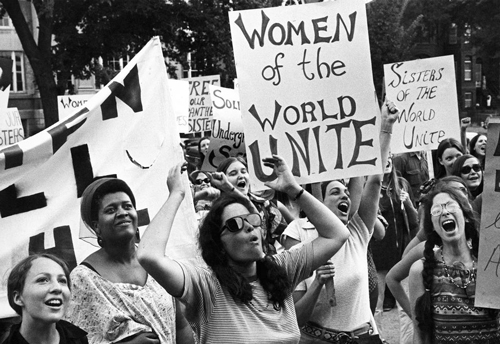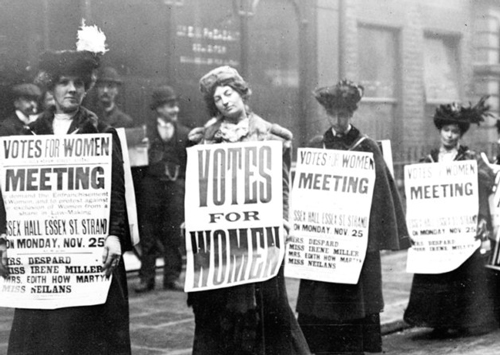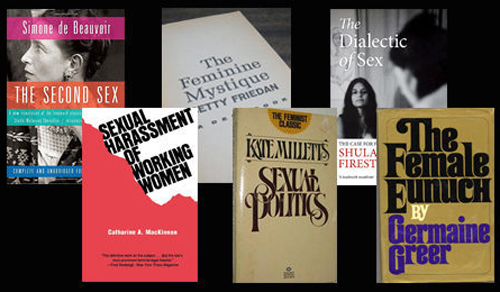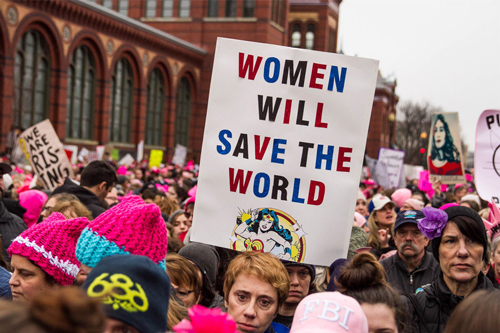The Feminist Seduction of Western Society
On January 16, 2018 the UK’s Channel 4 News uploaded its now-infamous interview between psychologist Jordan Peterson and newscaster Cathy Newman, treating viewers to a morbid yet fascinating display of feminist ideology careening face-first into the brick wall of reality. Scott Adams reckons Newman “effectively hallucinated about 12 times” as her ideology-warped consciousness became incapable of processing a word Jordan Peterson was saying.

Public response came fast and furious, with people overwhelmingly mortified by Newman’s inquisitorial display, shocked by witnessing the ‘pleasant’ face of feminism transform into Medusa-like destruction, yet glad to see feminism taken apart on a mainstream platform by Peterson’s rational and eloquent debating style.
Unable to ‘win’ the debate with Peterson, Newman and her allies in the liberal spectrum nevertheless eked out a ‘victory’ by casting themselves as victims and Peterson’s supporters as “vicious misogynists”. To protect their ideological beliefs, the situation was spun into its exact opposite, when clearly it was Newman and her ilk who are misandrists bent on victimizing men. ‘Security experts’ were brought in to add a veneer of truth to their spin. No verification of any actual threat has emerged – not against Newman or Channel 4 anyway, though some were leveled at Peterson and his followers.
What is going on when someone who is a professed feminist rebukes another for expressing genuine desire that his female students and clients succeed in their professional careers? The short answer is Feminism. The longer answer is similar, but a more radical, extremist version of it, which has taken hold in the mainstream and which many of its older advocates no longer recognize as Feminism.
Devastatingly low birth rates, high divorce rates, relationship dysfunction, and a war against the biological basis of male-female roles have resulted in the collapse of traditional society. And it can be traced back, in a variety of ways, to the feminist ideologues of the 20th century and the Marxist intellectual environment they emerged from. Feminist ideologues have poisoned the well of traditional society in order to provoke revolution from within.
The Origins of Feminism
“For the first time since the 1970s, feminism is popular again and commanding the world’s attention.” So begins an op-ed in the UK’s (ostensibly right-wing) Daily Telegraph, attributing its allegedly newfound popularity to the resurgence of ‘right-wing deplorables’. But this is completely backwards. Feminism is only “commanding the world’s attention” of late because, for the first time in decades, if not ever, its tenets are being publicly challenged. If the counter-culture seems to have increased in popularity of late, that’s only because it has been prompted to kick back, via its dominance of state organs, against the rising tide of ‘counter-counter-culture’.
The term ‘feminism’ was first coined by French socialist philosopher Charles Fourier (yes, a man) in the course of envisioning his utopian future. Writing in the lead-up to and aftermath of the French Revolution, in revolt against both the old Catholic authorities and their doctrines and the new ‘free market’ and ‘Enlightenment’ ideals, Fourier claimed to have discovered, scientifically, the ultimate truth and end of all society: the omniarch – a global government ruled by feminist and socialist forces.
His ideas, particularly those of social utopia, would inform Marx and Engels, as well as Americans like Ralph Waldo Emerson. The loss of his father, his ‘unscrupulous’ uncle, and a predominantly feminized upbringing no doubt lent considerable weight to the feminine nature of his utopia. As his biographer writes, “No longer constrained by monogamy, they were free to form simultaneous erotic or companionate relationships with several men. Women would control reproduction, just as children would be free to choose between real and adoptive fathers. The relation between the child and the mother would no longer be disrupted by the father, nor would it be inhibited by the legal and religious authority which protected the father’s power. Harmony was built upon the explicit elimination of such authority.” Clearly, Fourier’s own childhood, or rather the day-dreams conjured out of it, supplied much of the raw material from which this non-patriarchal utopia was composed.
Fourier’s ideas would become the most widespread socialist ideas of the day, ultimately influencing Communism. In America they inspired the failed socialist colony Brook Farm. Ralph Waldo Emerson, an enthusiastic supporter of Fourier’s ideas at first, became a counter-revolutionary after his experience. He writes: “Of course every visitor found that there was a comic side to this Paradise of shepherds and shepherdesses… The country members naturally were surprised to observe that one man ploughed all day and one looked out of a window all day… and both received at night the same wages.”

Marx expressed great satisfaction at Fourier’s attack on “every principle of existing society” while faulting it for its lack of revolutionary vigor. Marx would go on to write that, unknown to the bourgeoisie, “the real point aimed at by communists is to do away with the status of women as mere instruments of production.” Upon the founding of what would become the pathocratic Soviet Union, Fourier’s name was assigned a place of honor by the revolutionaries. The family was dismantled and, as Alexandra Kollontai wrote in 1920, the ‘old family’ was a thing of the past: “There is no escaping the fact: the old type of family has had its day. The family is withering away not because it is being forcibly destroyed by the state, but because the family is ceasing to be a necessity. The state does not need the family, because the domestic economy is no longer profitable: the family distracts the worker from more useful and productive labour. The members of the family do not need the family either, because the task of bringing up the children which was formerly theirs is passing more and more into the hands of the collective. In place of the old relationship between men and women, a new one is developing: a union of affection and comradeship, a union of two equal members of communist society, both of them free, both of them independent and both of them workers.”
Nowadays, when discussing feminism with just about anyone, especially someone of a liberal or progressive bent, one is bound to hear, “Of course Feminism was a good thing – women’s suffrage, the right to an education, the abandonment of spurious notions of ‘inherent evil’.” One easily forgives such sentiments because, who doesn’t want equality of opportunity for women? But ‘feminists’ have turned such naive acceptance of the apparent positive nature of their ‘cause’ into a smokescreen that hides a pernicious drive that threatens to destroy civil society as we know it.
‘Feminism,’ as it was formulated in the 18th and 19th centuries, was a schizoidal and mentally-deranged experiment from the get-go. By evolutionary design, men and women overwhelmingly fulfill fundamentally different roles, and ironically, many Western women, even activists, accepted these roles while agitating for equality of opportunity.
But by the mid-20th century the Great Feminist Matriarchs had taken this twisted child of Feminist ideology and turned it into the most misogynistic idea mankind has ever seen. Most were explicitly Communist in their approach – warping a fundamentally Western desire for freedom into a revolutionary construct for acquiring personal power.
With an ability to sexualize and de-humanize women more than any man could ever want to, the ‘great feminist authors’ make it clear through their writings that they intended to destroy the female in order to weaken Western society. There is perhaps no more misogynistic and female-hating mind than that of a die-hard feminist.
Twisted Sisters

From the years 1869 to 1920 American women fought for and earned their suffrage. By the year 1900, four out of five colleges had co-ed accommodations. From the 1900s on, the idea of the Independent Female Worker began to take shape, and with World War II millions of women joined the workforce and thousands joined the military. However, after the war, many went home to raise families and have children. By 1963 almost 80% of married women with children were not working outside the home.
Fundamentally disappointed by the fact that women were still playing the role of housewife, the feminist Germaine Greer wrote in The Female Eunuch that feminism had ‘failed’ – with particular resentment for the woman herself: “Five years ago it seemed clear that emancipation had failed: the number of women in Parliament had settled at a low level; the number of professional women had stabilized as a tiny minority; the pattern of female employment had emerged as underpaid, menial and supportive. The cage door had been opened but the canary had refused to fly out.”
Greer didn’t seem to consider that levels stabilized at low levels because women made the choices they wanted to make.
Spurred on by this pathology, many Feminist Manifestos were published, each aimed at putting the fire under the collective female behind and turning them into revolutionaries. Simone de Beauvoir published her 900-page tome The Second Sex in 1953. Ten years later, Betty Friedan published The Feminine Mystique in 1963, with both Germaine Greer and Shulamith Firestone publishing their own tomes in 1970. Common to them all were the tones of oppression and revolution, with hatred for both men and women dripping from every word.
Each writer accepted as fundamental that women were in some way different from men – and their understanding of said differences filled volumes, ranging from the way they dressed, their attitudes, their roles in society, etc. It was from this keen understanding that the Feminist Matriarchs understood what their revolution needed to accomplish, as well as their tactics for getting it done. Men’s love for women would be their weapon. The destruction of the family, and emasculating men, would be their goal.
Shulamith Firestone wrote exactly what needed to happen in The Dialectics of Sex: “Unless revolution uproots the basic social organization, the biological family – the vinculum through which the psychology of power can always be smuggled – the tapeworm of exploitation will never be annihilated.” She elaborated, with characteristic bluntness: “Pregnancy is barbaric”; childbirth is “like excreting a pumpkin”; and childhood is “a supervised nightmare.” Firestone didn’t love women; she just hated life.
Like a predator homing in on its prey, Simone de Beauvoir identified in the first “Great Feminist Manifesto” of the 1950s, The Second Sex, exactly what needed to be exploited to incubate the revolution; male empathy: “here is nonetheless one advantage woman can gain from her very inferiority: since from the start she has fewer chances than man, she does not feel a priori guilty toward him; it is not up to her to compensate for social injustice, and she is not called upon to do so. A man of goodwill feels it his duty to ‘help’ women because he is more favored than they are; he will let himself be caught up in scruples or pity, and he risks being the prey of ‘clinging’ or ‘devouring’ women because they are at a disadvantage.”

Germaine Greer, author of The Female Eunuch, was very explicit that Communist ideals were the only thing that could provide ‘liberation’: “The New Left has been the forcing house for most movements, and for many of them liberation is dependent upon the coming of the classless society and the withering away of the state.”
But what was their inspiration? Was it equality, or freedom for women? No, their inspiration was a deep loathing of men, women, and children. This pathology is nowhere more clear than in Firestone’s definition of love. For her, love was “the height of selfishness: the self attempts to enrich itself by the absorption of another being.” And her account of rearing children? It couldn’t get more disgusting: “The mother who wants to kill her child for what she has had to sacrifice for it (a common desire) learns to love that same child only when she understands it is as helpless, oppressed as she is and by the same oppressor; then her hatred is directed outward and ‘motherlove’ is born. But we will go further: our final step must be the elimination of the very conditions of femininity and childhood themselves that are so conducive to the condition of the oppressed, clearing the way for a fully ‘human’ condition.”
Family is oppression, nature is oppression, men are oppression, women and children must revolt. Firestone raised her voice for the total destruction of the family unit, and the New Yorker lauded her.
Marriage was fundamentally oppressive because, Shulamith notes, men “cannot love and never will be able to.” Indeed, if love is what Germaine Greer said it was, it’s unlikely any man of goodwill would be interested in it. Greer is clear when she writes: “If women are to effect a significant amelioration in their condition, it seems obvious that they must refuse to marry.” Hundreds of thousands of copies of their books were sold, and their adherents began a long and slow march through the institutions, where being female was their power, and claiming victimhood was their tactic. But it was Betty Friedan who did most to wage war on ‘the most fundamentally oppressive institution’ – marriage.
The War on Marriage & the Family
For Betty Friedan, like the other Feminists, family was a “comfortable concentration camp.” Theirs was a war against it. In The Feminist Mystique Friedan dishonestly depicts herself as a simple housewife who understood the spiritual needs of the typical American woman. She was anything but that.
Friedan had joined the Young Communist League as a youth and had twice attempted to join the Communist Party as an adult, after a professor of hers at Smith College introduced her to Feminism. This professor was also the head of a Communist front group and had been a fee-paying Communist for years, divorcing her anti-Communist husband. Friedan became an avid writer for Communist causes and came to endorse the Cause. From then on, for her, “The emancipation of women becomes possible only when women are enabled to take part in production on a large, social scale, and when domestic duties require their attention only to a minor degree.”

After Betty Friedan started an activist women’s organization called the National Organization for Women (NOW), its activists helped launch a number of legal initiatives for equal rights in the workplace, the outlawing of marital rape, and ultimately the implementation of no-fault divorce laws nationwide. It’s no coincidence that the first modern no-fault divorce law was enacted in Russia after the Bolshevik Revolution in December 1917. The same revolutionary forces at work in Soviet Russia also successfully re-wrote much of the American legal system – both criminal and civil law.
The effect on society has been catastrophic and, as many note, likely irreversible. While half of marriages end in divorce, wives now initiate close to 70% of all of them, and joint custody of children is awarded to men only 20% of the time. What no-fault divorce laws mean are that any partner can initiate a divorce for any reason whatsoever. This translates into a colossal intrusion of government into the homes of a large percentage of American families – all under the guise of ‘female empowerment’.
As Stephen Baskerville writes in The New Politics of Sex: “Divorce instantly destroys fatherhood and, by extension, parenthood. The moment one spouse files for divorce, even if it is literally for ‘no fault’ of the other spouse, the innocent parent enters the penal system: to raise his children as he sees fit according to his own values – to even be with his children without government authorization – is henceforth a crime for which he can be arrested and incarcerated indefinitely without trial. And there will be no record of the incarceration. Few enterprises have forged so intimate and elaborate a public-private symbiosis. More than four decades of unrestrained divorce has created a vast industry with a stake in maximizing it. David Schramm cautiously estimated that divorce cost the public $33.3 billion annually in 2003.”
According to Charles Murray, in 1963 a divorced person headed only 3.5% of households in the US – regardless of education level. From 1960 to the late 1990s the number of children living without their biological father increased from 17% to 36% – and 70% of children in state institutions were from fatherless homes. 90% of all runaway or homeless children were from fatherless homes. Now a record number of people never even marry – they are, no doubt, haunted by the divorce of their parents, or incapable of finding a marriageable partner in such a dysfunctional society. No surprise, then, that more women are childless than at any other recorded time.
The US birth rate has dropped from 81.6 (for 1,000 people) in 1950 to 22.3 in 2015, and the general fertility rate has fallen for eight straight years now, according to the New York Times. In After the Empire: The Breakdown of the American Order, author Emmanuel Todd writes about his 1975 prediction of the collapse of the Soviet Union. He writes: “Trained as I was as both a historian and a demographer, I declared, contrary to conventional thinking, that the lower birth rate in the Soviet Union – 42.7 births for one thousand inhabitants in the years 1923-1927, 26 for the years 1950-1952, and 18.1 in 1975 – would cause perfectly normal Russian citizens to rise up and overthrow communism. In the case of Russia, as with France and Germany, the transition was a particularly unsettled period during which the changes in sexual behavior aggravated the disorientation linked to the rise of literacy. This disorientation corresponds to the Stalinist era.”
This points out a deep similarity between the ‘feminism’ of the Soviet Union and the ‘feminism’ of the modern West. Changes in amorous behavior are triggering a societal bewilderment and frustration, one that is exactly what the early revolutionaries wanted.
Weaponization of Sexuality

With the institution of marriage destroyed, and with it the restraints on amorous behavior as well as the moral guidance of young adults, it seems we are now seeing a new stage, one of the weaponization of sexuality. Feminist have long urged everyone to explore their sexuality; they have effectively turned that sexuality into a political weapon. No longer are sex crimes based on objective evidence; now they are based on the subjective interpretation of the victim – a female who is rarely doubted. So, while young couples are encouraged to explore their sexuality by night, the women are encouraged to report a rape by day. And, if not that extreme, then they are encouraged to report their man for being a ‘poor lover,’ as is made obvious in the Aziz Ansari and Cat Person stories that went viral in 2018.
Or, if you simply want to exercise your power over a male, you can always falsely accuse. There are many stories like these. Consider that of professor Steven Galloway. A chair at the University of British Columbia, Galloway was accused of rape and, without even as much as an inquiry or even an alert that he had been accused, the University issued a public statement condemning him and insinuating to the public that he was a “violent serial rapist”. Even after a judge found no evidence of sexual abuse, Steven Galloway was still fired from his job.
Justice has been inverted and, using political power, feminists have managed to criminalize men – their number one enemy – destroy fatherhood, destroy motherhood, criminalize lovemaking. As Stephen Baskerville writes in The New Politics of Sex: “Many have discerned [in Feminism] an affinity with older ideologies like Marxism, but few appreciate how far sexual radicalism expands socialist logic and intrusiveness.”
“Women’s liberation, the most influential neo-Marxist movement in America, has done to the American home what communism did to the Russian economy, and most of the ruin is irreversible,” writes Ruth Wisse. “By defining relations between men and women in terms of power and competition instead of reciprocity and cooperation, the movement tore apart the most basic and fragile contract in human society, the unit from which all other social institutions draw their strength.”
These feminists created and control the vast and impenetrable social services industries that most journalists and scholars find too dreary to scrutinize. In the US they dominate the $53 billion federal Administration for Children and Families, itself part of the gargantuan trillion dollar Department of Health and Human Services. They are both dispensers and recipients of its $350 billion grant program (“larger than all other federal agencies combined,” according to HHS) funding local “human services” or “social services” bureaucracies – by far the largest patronage machine ever created, reaching into almost every household in the land and making the Soviet nomenklatura look ramshackle. They created and control the “family law sections” of the bar associations and family courts, which they modified into their image from an earlier incarnation as juvenile courts (rationalized by “caring” and “compassion”). And they dominate the forensic psychotherapy industry, with its close ties to the courts, social service agencies, and public schools. By no means are they all doctrinaire devotées of The Feminine Mystique or The Female Eunuch. But when push comes to shove, they understand that their power comes from being female.
Conclusion

For the Feminist, the war on the family has been a resounding success – women have been “liberated” from the “comfortable concentration camp” of the family. In the process women are more likely to be unhappy, while many young women grow up feeling that a natural desire to raise a family is fundamentally wrong.
For men, separated from their fathers, masculinity has never been more precarious. The female has taken their role, and they have nothing else to provide. The very traits that fathers instilled in their sons – the use of reason, the capability to suffer and work without reward, the desire to be responsible for the family – these traits have died, leaving an entire generation at the whim of postmodern, radical Leftist revolutionaries.
Devastatingly low birth rates, high divorce rates, relationship dysfunction and a war against instinctual concepts of male and female – all of this explains the immense popularity of Jordan Peterson. This is why his YouTube videos are predominantly viewed by men. In a world where even the most basic human truths are assaulted on a daily basis, Peterson offers the struggle for Truth. Young men and women are starving for it. The veneer of ‘victimhood’ is growing thin.
yogaesoteric
March 27, 2020
